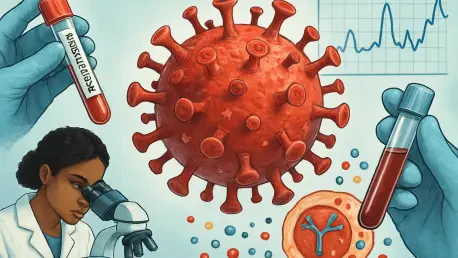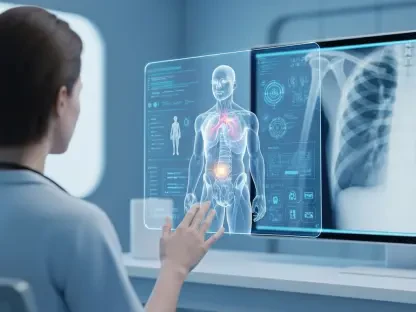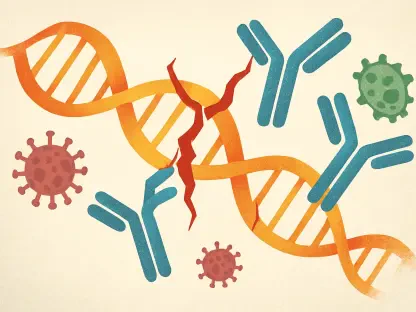The COVID-19 pandemic has presented an unprecedented challenge to global health, revealing intricate and often devastating ways in which the SARS-CoV-2 virus disrupts the human body at a molecular level, particularly in severe cases characterized by rampant inflammation and life-threatening blood clotting. While much has been learned about the virus since its emergence, gaps remain in understanding the precise mechanisms behind these severe outcomes, leaving clinicians and researchers racing to find reliable indicators of disease progression and effective treatments. A groundbreaking study published on October 8, 2025, in a leading infectious disease journal has taken a significant step forward by delving into the body’s complement and coagulation cascades (CCC) pathway—a critical system for immune defense and blood clotting—and identifying two proteins, FGB (fibrinogen beta chain) and SERPINA5 (plasma serine protease inhibitor), as potential biomarkers for severe COVID-19. This research, conducted by a dedicated team of scientists, harnesses the power of bioinformatics and proteomic analysis to uncover molecular clues that could transform diagnostic and therapeutic approaches. By exploring how these proteins contribute to the chaos unleashed by the virus, the findings not only deepen the understanding of COVID-19’s impact but also highlight promising avenues for personalized medicine. This article aims to unpack the study’s revelations, guiding readers through the pivotal role of the CCC pathway, the innovative methods used to pinpoint key proteins, and the implications for future clinical strategies.
Unraveling the CCC Pathway’s Role in Severe COVID-19
The complement and coagulation cascades (CCC) pathway stands as a fundamental pillar of the body’s defense mechanisms, seamlessly integrating the immune system’s complement responses with the intricate process of blood clotting to combat infections and support tissue repair. This dual functionality is essential under normal conditions, acting as a first line of defense against pathogens while ensuring injuries are addressed through clot formation. However, in the context of COVID-19, this normally protective system becomes a double-edged sword. Research has shown that SARS-CoV-2 triggers profound dysregulation within the CCC pathway, leading to excessive inflammation and abnormal clotting that can wreak havoc on vital organs, particularly the lungs. This disruption often manifests as a cascade of complications, pushing the body into a state of overreaction that can be more harmful than the virus itself. The pathway’s malfunction is now recognized as a central driver of severe disease, making it a critical area of study for understanding why certain patients face dire outcomes. By focusing on this system, scientists aim to decode the molecular underpinnings of these devastating effects, offering hope for targeted interventions that could mitigate the worst impacts of the infection.
Further exploration in the recent study reveals that the CCC pathway’s dysregulation in COVID-19 patients is alarmingly comprehensive, affecting all five complement activation routes—classical, lectin, alternative, intrinsic, and extrinsic—when compared to healthy individuals. This widespread disturbance creates a systemic imbalance, contributing to severe manifestations such as endothelial damage, where the delicate lining of blood vessels is compromised, and microvascular thrombosis, characterized by tiny but dangerous blood clots that impair circulation. These conditions are often precursors to critical outcomes, including respiratory failure and multi-organ damage, which are tragically common in severe cases. The evidence points to a vicious cycle where inflammation fuels clotting, and clotting exacerbates inflammation, trapping patients in a downward spiral. Understanding this intricate interplay is vital for clinicians seeking to predict which patients are at greatest risk and for researchers striving to develop therapies that can interrupt this destructive feedback loop. The CCC pathway, therefore, emerges not just as a victim of SARS-CoV-2’s assault but as a key battleground where the fight against severe COVID-19 must be waged with precision and insight.
Harnessing Proteomics to Reveal Molecular Disruptions
To penetrate the molecular mysteries of COVID-19’s impact on the CCC pathway, the research team turned to proteomics, an advanced scientific approach that examines the complete set of proteins within a biological sample to detect alterations associated with disease states. This method offers a detailed view of how the virus reshapes protein expression, providing critical data that goes beyond genetic analysis to capture real-time changes in the body’s functional machinery. By synthesizing information from 20 meticulously chosen studies, the researchers cataloged over 3,000 differentially expressed proteins (DEPs) in COVID-19 patients, ultimately refining this list to 2,352 unique genes for deeper scrutiny. This vast dataset served as a foundation for identifying specific molecular signatures linked to disease severity, demonstrating the power of proteomics as a tool for unraveling complex health challenges. The scale of the analysis underscores the profound disruptions caused by SARS-CoV-2, painting a vivid picture of a biological system under siege and highlighting the urgency of translating these findings into actionable medical insights.
Among the identified proteins, a striking 58 genes were found to be directly associated with the CCC pathway, accounting for nearly two-thirds of its total components and illustrating the extensive reach of the virus’s interference. Leveraging sophisticated technologies like mass spectrometry, the team mapped out these protein shifts, creating a comprehensive snapshot of the molecular landscape altered by infection. This approach revealed not just the breadth of changes but also their depth, as many of these proteins play pivotal roles in regulating immune and clotting responses. The proteomic profiling offers more than raw numbers—it provides a window into how these changes correlate with clinical outcomes, helping to identify patients who might face the most severe consequences of the disease. Such detailed mapping is a crucial step toward developing diagnostic tools that can flag high-risk individuals early, potentially saving lives through timely intervention. The focus on the CCC pathway through this lens emphasizes the need to target specific proteins for both understanding the disease and crafting effective responses to its challenges.
Pinpointing Hub Genes as Central Regulators
Delving deeper into the proteomic data, the researchers employed cutting-edge bioinformatics tools such as Cytoscape and STRING to construct detailed protein-protein interaction networks, uncovering which components of the CCC pathway are most central to its dysfunction during COVID-19 infection. These networks act like a roadmap, highlighting the connections and dependencies among proteins that orchestrate the body’s immune and clotting responses. Through this meticulous analysis, 16 hub genes were identified as key regulators, standing out for their significant influence over the pathway’s behavior under the stress of SARS-CoV-2. These genes are not mere bystanders but active players in the molecular drama unfolding in infected patients, making them critical targets for further investigation. Their identification marks a pivotal moment in the study, narrowing down a vast field of data to a manageable set of focal points that could hold the key to understanding severe disease progression. This step forward brings clarity to a complex problem, offering a foundation for exploring how specific molecular actors drive the devastating effects seen in critical cases.
Of these hub genes, four emerged as particularly noteworthy due to their consistent patterns of expression across multiple datasets: FGB, FGG, F2, and SERPINA5. The proteins FGB and FGG, both integral to fibrinogen—a cornerstone of blood clotting—were found to be markedly upregulated, indicating elevated levels in COVID-19 patients that likely contribute to excessive clot formation. Conversely, F2, associated with thrombin and crucial for clotting activation, and SERPINA5, a protective inhibitor of proteases, were downregulated, suggesting a dangerous loss of regulatory balance that could exacerbate inflammation and tissue damage. These contrasting trends reveal a disrupted equilibrium within the CCC pathway, where protective mechanisms falter while harmful processes gain momentum. The consistent behavior of these four genes across studies lends weight to their potential as reliable indicators of disease severity, positioning them as focal points for both diagnostic and therapeutic exploration. Their roles as central regulators highlight the intricate ways in which SARS-CoV-2 manipulates the body’s natural defenses, turning them against the host with potentially lethal consequences.
Highlighting FGB and SERPINA5 as Diagnostic Markers
A deeper focus on FGB and SERPINA5 reveals their exceptional promise as biomarkers for identifying severe COVID-19, with their significance validated through robust scientific methods such as meta-analysis and immunohistochemistry (IHC) conducted on patient tissues. FGB’s notable upregulation was evident in the data, showing a 1.5-fold increase in affected lung cells among COVID-19 patients, alongside a heightened presence that points to its involvement in promoting dangerous blood clotting and pulmonary fibrosis, a scarring of lung tissue that impairs breathing. This protein’s elevated levels suggest it plays a direct role in the pathological processes that make severe cases so challenging to manage, offering a measurable signal of disease progression. The ability to detect such changes could enable healthcare providers to identify at-risk patients before their condition deteriorates, providing a critical window for intervention. The clear link between FGB’s behavior and clinical outcomes underscores its potential as a diagnostic tool, bringing molecular insights into the realm of practical patient care.
In stark contrast, SERPINA5 exhibited significant downregulation, with a measurable decrease in lung tissue samples from infected individuals, indicating a diminished capacity to protect against viral replication and maintain tissue integrity. This reduction, evidenced by a 1.3-fold drop in positive cells and a nearly twofold decrease in optical density during IHC analysis, suggests that the body’s natural defenses are compromised, allowing SARS-CoV-2 to inflict greater damage. The opposing dynamics of FGB and SERPINA5—one rising while the other falls—illustrate how the virus exploits imbalances in protein function to worsen illness, creating a molecular tug-of-war with serious consequences. Validation through direct tissue analysis adds a layer of credibility to these observations, confirming that the changes detected in proteomic studies reflect real alterations in the body. As potential biomarkers, FGB and SERPINA5 could revolutionize the approach to triaging patients, enabling earlier identification of those likely to develop severe symptoms and tailoring treatments to their specific molecular profiles for better outcomes.
Exploring Therapeutic Potential of Key Proteins
Beyond their diagnostic value, the identified hub genes, particularly FGB and SERPINA5, hold substantial promise for therapeutic development, as explored through databases like Open Targets to evaluate their potential as drug targets. For FGB, along with related proteins FGG and F2, connections to existing FDA-approved medications, such as anticoagulants and direct thrombin inhibitors, offer a starting point for repurposing treatments to address the clotting complications seen in severe COVID-19. These drugs, already in clinical use for other conditions, could be adapted to counteract the overactive clotting driven by upregulated proteins like FGB, potentially reducing the risk of life-threatening thrombosis in affected patients. This avenue represents a practical application of the study’s findings, leveraging established pharmaceutical options to meet an urgent need in managing the disease. The existence of such therapies provides a head start, allowing researchers and clinicians to test their efficacy in the context of COVID-19 without the lengthy timeline of developing entirely new compounds, thus accelerating the path to effective care.
SERPINA5, however, presents a different and intriguing scenario, as it currently lacks any clinically approved drugs targeting its function, positioning it as an untapped frontier for innovation in treatment strategies. Its downregulation in COVID-19 patients, coupled with its protective role against viral spread and tissue damage, suggests that boosting its activity or mimicking its effects could offer a novel way to bolster the body’s defenses. The broader relevance of SERPINA5, including its associations with outcomes in conditions like cancer, further amplifies its appeal as a target with potential applications beyond infectious diseases. Developing therapies for this protein could open new doors not only for managing severe cases of COVID-19 but also for addressing other medical challenges, highlighting the far-reaching impact of such research. While the road to creating and testing new drugs is complex, the identification of SERPINA5 as a candidate for intervention marks a forward-thinking direction, encouraging investment in innovative approaches to restore balance to the CCC pathway and mitigate the virus’s destructive effects.
Future Directions in Biomarker Research
The insights gained from pinpointing FGB and SERPINA5 as key players in COVID-19 pathogenesis mark a significant advancement, yet they also illuminate the challenges and limitations that must be addressed through future research. One pressing issue is the heterogeneity in existing proteomic data, stemming from variations in study designs, sample types, and patient characteristics such as disease severity or viral strain. This inconsistency can cloud the interpretation of findings, making it difficult to draw universal conclusions about the roles of these biomarkers. Additionally, the current study focused on a limited number of validated genes, leaving questions about the broader applicability of other hub genes within the CCC pathway. Addressing these gaps requires standardized methodologies across studies to ensure comparability and reliability of results, paving the way for more confident clinical translations. The complexity of these challenges underscores the need for a coordinated scientific effort to refine the understanding of molecular disruptions in COVID-19 and build a robust foundation for practical applications.
Looking ahead, the path forward involves not only overcoming methodological hurdles but also conducting functional studies to elucidate the precise mechanisms by which FGB and SERPINA5 influence disease outcomes. Experimental validation through larger, more diverse patient cohorts will be essential to confirm their roles as biomarkers and therapeutic targets, ensuring that findings hold true across different populations and contexts. Furthermore, integrating these molecular insights with clinical data could enhance predictive models, allowing for more accurate risk stratification and personalized treatment plans. The potential of SERPINA5 as a novel drug target, in particular, warrants dedicated research into developing compounds that can modulate its activity, offering hope for innovative therapies. As the scientific community builds on these discoveries, collaboration between researchers, clinicians, and pharmaceutical developers will be crucial to transform proteomic data into tangible solutions, ultimately improving the management of severe COVID-19 and preparing for future pandemics with greater precision and resilience.









